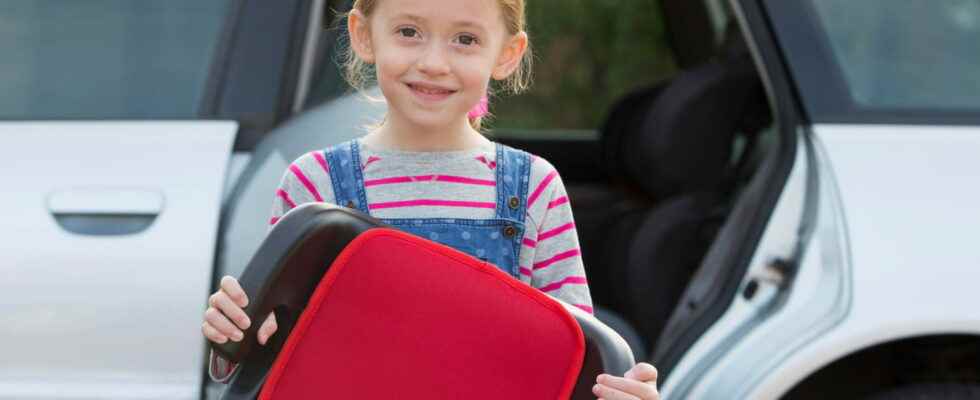From a certain height and weight, children must switch to a booster seat during car journeys. How do you know when to give up the shell or the car seat for a booster seat? With or without backrest, how to choose it? Our advices.
At what age should you switch from a car seat to a booster seat in the car? This essential and compulsory accessory for children, at least up to about 10 years old, is to be chosen according to the size and weight of the child. In general, when the child’s shoulders pass the high position of the harness, it is time to choose a car booster. There are also different models of booster seats, but not all are created equal. Our advice for correctly choosing a booster seat for your child.
What is a car booster, what is it used for?
The booster seat ensures the safety of the child on board a car. In concrete terms, when the child is seated, it allows him to keep him at an adequate height so that the seat belt can fulfill its role of protection in the event of an impact.
At what age can my child switch to a booster seat in the car?
Generally, a child can switch to the booster seat in the car between 3 and 4 years old. But age is not the only criterion to take into account. The transition to the booster seat depends more on the size and weight of the childbecause each child does not always have the same morphology even if they are the same age.
What size should the child be to go to the booster seat?
Road safety experts recommend switch to a booster seat when the child is between 1 meter and 1.50 meters tall. To find their bearings, the booster generally replaces the car seat when the child’s shoulders exceed the highest position of the harness integrated into the car seat device.
At what age to switch from harness to belt?
From the age of 10, if the morphology is suitable for wearing a seat belt, your child can simply be held in place by a seat belt.. It can be installed in the front as well as in the rear of the car. However, it is advisable to keep the booster seat for the child until the age of 11-12 years for safety. A seat belt exemption is only possible for medical reasons (morphology unsuitable for wearing a seat belt or medical certificate of exemption).
Is the booster seat compulsory in the car, what does the law say?
The law specifies that an approved restraint system is compulsory from 0 to 10 years and that there are 5 groups of retainers. Booster seats are authorized from group 2 which concerns children from 15 to 25 kg and from group 3 which concerns those from 22 to 36 kg and are only suitable for children under 1.50 m. Know that a driver who does not respect these obligations can be punished with a fine of up to 750 euros. In general, this is a fixed fine of 135 euros.
Which model of booster should I choose for my child?
Choosing a booster seat for your child requires checking certain criteria. With or without a backrest, the booster seat must meet the safety and quality standards in force in Franceto know :
- The R129 or i-Size standard classifies devices according to the size of the child. Booster seats with this standard are suitable for children who measure between 1 m and 1.50 m. In addition, all i-Size seats must have the Isofix secure attachment system, mandatory in new vehicles since 2011, and have a backrest.
- Standard R44/04 (group 2 and 3) takes into account the weight of the child. The booster seats that meet these requirements are intended for children whose weight is included between 15 and 36 kg.
Afterwards, it is important to ensure that the booster seat is adapted to the child’s morphology, height and weight. Experts also adviseavoid turning to a second-hand booster seat modelbecause it will already be used and the safety elements could be damaged. Don’t neglect the comfort of a booster seat, either. To do this, have your child test the booster seat, he must feel good on it, while being safe. Here is our selection of booster seats for children:
When to use a backless booster?
Since 2017, backless booster seats are approvedunder standard R44/04, only for children in group 3, therefore weighing more than 22 kg and whose height is greater than 1.25 m. However, specialists do not recommend these models because the back of the booster seat precisely forms a shield that protects the back, neck and head of children in the event of an impact and prevents their head from falling to the side during a nap. Moreover, backless booster seats make it difficult to position the seat belt.
First of all you have to install the booster seat facing the road, on the back seat and not on the front seat. Then, if your booster seat model is equipped with clips for the belt, position it in the guides provided for this purpose. Once your child is seated on the booster seat, check that it is the correct size, then place and fasten the seat belt as for an adult. If necessary, adjust the seat belt so that the child is well supported, it should not be too tight either. The seat belt will thus retain the child and at the same time retain the booster seat.
Sources:
Car seat priority. Road Safety Association (October 2022)
Car seat: what uses, for whom? Government Road Safety
Seat belt, child or baby car seat: what are the rules? Public Service (October 2021)
